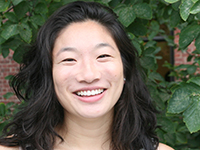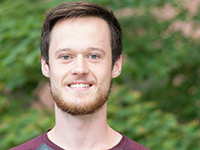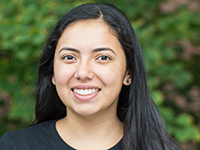The National Science Foundation (NSF)’s prestigious Graduate Research Fellowship Program (GRFP) provides funding to promising graduate students. This fall, six MCO graduate students– Easun Arunachalam, Karen Bao, Megan He, Alex McQuown, Hope Merens, and Paula Pelayo–will receive stipends and tuition support through the program.
NSF Graduate Research Fellows receive a three-year annual stipend of $34,000 plus a $12,000 allowance for tuition and fees. Since its inception in 1952, the NSF GRFP has produced 42 Nobel Laureates and dozens of influential researchers and teachers. It is the oldest program of its kind in the country. Each applicant submits a personal statement along with a research proposal outlining a potential experiment. The fellows are chosen from the highly competitive pool based on the applicant’s potential to become leaders in scientific innovation and teaching.
Easun Arunachalam [G1]
Easun Arunachalam comes from an engineering background and is interested in how living systems expend energy to promote self-organization and ensure stability. “I am interested in understanding the structure and dynamics of sub-cellular structures and the underlying sources of heat generation — the energy that is expended but does not contribute to useful work,” he says. “It may be that the thermodynamic balance between work and heat production in biological systems can give us clues about how the gears are turning, so to speak.”
In undergrad, Arunachalam mostly explored biophysical systems through theoretical and computational techniques. His GRFP funding will allow him to conduct hands-on experiments in calorimetry and microscopy to understand dissipation in mixtures of purified microtubules (cellular “ropes”) and molecular motors, and metabolism in developing embryos.
Arunachalam is currently working with Professor Daniel Needleman, who holds a joint appointment in Harvard SEAS and MCB. “I would like to thank Dan Needleman and the entire Needleman lab for their guidance and encouragement,” Easun says. “It has been rewarding to work with this diverse group of physicists, engineers, and biologists to explore our common interests. I would also like to thank Fanuel Muindi, Allie Pagano, Katie Scrocca at the MCO office, and Harvard’s MRSEC, which provides a good deal of the instrumentation that makes this work possible.”
Karen Bao [G1]
Marine biologist and sci-fi author Karen Bao arrives at Harvard with the goal of learning more about how organisms work at the cellular level. “I studied marine ecology as an undergraduate and came to MCO for a deep understanding of molecular and cellular biology,” she says. “My long-term goal is to use the knowledge and skills from this program to more deeply understand threatened natural populations and ecosystems. This could mean studying different species’ genetics, evolution and adaptation, physiology, or sensory systems.”
After conducting field research (and relying on makeshift field “labs” such as a hut on a beach in Fiji), Karen is looking forward to learning new techniques through her laboratory rotations. “My top priority is learning to design lab experiments using the myriad tools available to me,” she says.
She is grateful to Dr. Simon Thorrold and Dr. Carolyn Tepolt at Woods Hole Oceanographic Institute, who helped her develop her research proposal for the NSF GRFP application, which focused on using molecular techniques to understand the structure of French Polynesian coral reefs. “I’m also grateful to my undergraduate research advisor, Dr. Joshua Drew, for his mentorship over the years,” she adds.
Megan He [G1]
Megan He will begin her training as a stem cell scientist at Harvard this fall. An undergraduate course in stem cells piqued her interest, and she plans to explore that interest through at least one lab rotation this fall. “I am excited about using these rotations to continue exploring the utility of stem cells as a therapeutic, though I have not ruled out immersing myself in a new field during this period of exploration,” she says.
Applicants to the GRFP submit a personal statement and a project proposal. Megan’s proposal focused on using single cell RNA sequencing to catalogue mesenchymal stromal cells in order to further characterize the cells’ properties, including the wound-healing biomolecules those cells secrete.
She says the fellowship funds will allow her to participate in outreach activities as well as pursue her goals in the lab. “I attribute my interest in science to the mentorship and opportunities available to me as a child, and I would love to be able to provide that to others and help train the next generation of scientists,” Megan adds. She plans to participate in Harvard Medical School’s HPREP (Health Professions Recruitment & Exposure Program), which offers STEM education opportunities to high school students from underserved communities in and around Boston.
Alex McQuown [G3] (Denic Lab)
Alex McQuown‘s interest in cellular organization began in a departmental seminar at the University of Minnesota, where he attended undergrad. “At these seminars I would see cartoons of molecular motors crawling along filaments and carrying cargo, and would see microscopy movies of cells dividing and crawling and reorganizing their contents,” he recalls.”I was fascinated.”
Today, his work in Prof. Vlad Denic’s lab focuses on how cells recognize and get rid of defective membrane proteins. Picking defective proteins out of a crowd of thousands of normal, fully-functional proteins is tricky, but cells manage it on a regular basis. “This process raises an interesting question,” Alex says. “How can cells differentiate between defective and functional proteins so as to quickly remove and destroy defective proteins while leaving functional proteins alone to do their jobs?”
His research uses yeast as a model system for studying how a particular set of proteins in the membranes of detoxification organelles called peroxisomes manage this process. “We still don’t understand how [the cell’s] quality control machinery can differentiate between membrane proteins that need to be removed and destroyed and membrane proteins that need to be left alone so they can perform their functions,” he explains.”I aim to use a variety of genetic and biochemical techniques to learn how the quality control protein Msp1 can recognize peroxisomal membrane proteins destined for destruction.”
A mutation in a gene similar to Msp1 in humans causes lethal neurological problems. The fellowship funding will enable Alex to continue this work and perhaps take on bolder, riskier experiments. He also hopes that the new fellowship will empower him to establish international collaborations.
“Thanks to the MCB department for doing a great job of supporting its students and for really encouraging and pushing us to apply for fellowships like the NSF GRFP Fellowship,” he says. “Also, thanks to Vlad [Denic] for being a supportive mentor and always helping to guide and nurture my project as it matures, while also providing the freedom to try my own ideas and make mistakes. Vlad’s mentorship has been instrumental in my growth as a graduate student and I couldn’t have succeeded in acquiring the NSF fellowship without his support.”
Hope Merens [G1]
Neuroscientist Hope Merens plans to use cutting-edge microscopy techniques to shed light on the developing brain. “I’m really interested in studying molecular mechanisms that contribute to neurodevelopment, and helping to create a better understanding of how the interactions of different molecules can lead to complex, specific relationships between different neurons in the developing brain,” she says.
“It’s such an exciting time to be studying neuroscience using new microscopy techniques like super-resolution microscopy [for tracking molecules that are smaller than the diffraction limit], which allows for imaging neurons and synapses in previously impossible detail,” she adds.
Her project proposal for the NSF GFRP application focused on combining existing biophysical techniques to find out more about why the Piezo1 channel in neurons opens in response to force. In the coming year, she hopes to learn more about the math and physics behind advanced techniques and to try working with model systems that she hasn’t had a chance to work with in the past, such as the fly Drosophila.
“MCO has been such an inviting and supportive community, even in my first few days here,” Hope says. “It’ll be interesting to look back a year from now.”
Paula Pelayo [G1]
Paula Pelayo’s undergraduate experience at UCLA inspired her GRFP research proposal on single-celled parasites called trypanosomes. These protozoans, which are the culprits behind “sleeping sickness,” use their whip-like flagella to get around and are a popular organism for investigating how flagella work.
“Flagella are important for motility and sensory functions,” Paula explains. “My proposal was aimed at identifying novel proteins within the microtubules that would help expand our knowledge of flagellar biology by revealing new functions of conserved and parasite-specific proteins.”
She is also interested in interactions between genes and evolution more broadly. “As I begin my graduate studies in MCO I look forward to continuing exploring genetics and evolution and am currently looking for labs to rotate in,” she says. “I feel fortunate for having received this fellowship because in addition to supporting my research, it will provide me with professional development opportunities including the possibility to explore a non-academic research internship.”
by Diana Crow









